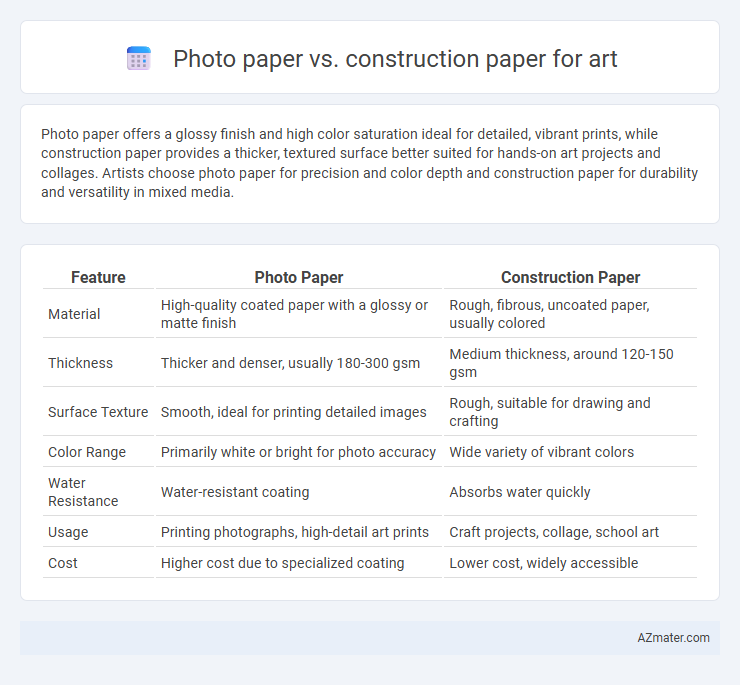Photo paper offers a glossy finish and high color saturation ideal for detailed, vibrant prints, while construction paper provides a thicker, textured surface better suited for hands-on art projects and collages. Artists choose photo paper for precision and color depth and construction paper for durability and versatility in mixed media.
Table of Comparison
| Feature | Photo Paper | Construction Paper |
|---|---|---|
| Material | High-quality coated paper with a glossy or matte finish | Rough, fibrous, uncoated paper, usually colored |
| Thickness | Thicker and denser, usually 180-300 gsm | Medium thickness, around 120-150 gsm |
| Surface Texture | Smooth, ideal for printing detailed images | Rough, suitable for drawing and crafting |
| Color Range | Primarily white or bright for photo accuracy | Wide variety of vibrant colors |
| Water Resistance | Water-resistant coating | Absorbs water quickly |
| Usage | Printing photographs, high-detail art prints | Craft projects, collage, school art |
| Cost | Higher cost due to specialized coating | Lower cost, widely accessible |
Introduction to Photo Paper and Construction Paper
Photo paper is a specially coated paper designed to produce high-quality photographic prints with vibrant colors and sharp details, making it ideal for photo-based art projects. Construction paper is a heavier, textured paper typically used for crafts and school projects, known for its wide range of bright colors and durability. Both materials serve distinct purposes in art, with photo paper excelling in image reproduction and construction paper favored for its versatility and tactile qualities.
Material Composition and Texture Differences
Photo paper is typically coated with a smooth, glossy or matte finish designed to enhance color vibrancy and sharpness, made from high-quality cellulose fibers and chemicals that resist ink absorption for precise image reproduction. Construction paper is composed of coarse, uncoated wood pulp fibers with a rough texture, optimized for durability and ease of cutting, folding, and gluing in craft projects. The distinct material composition and surface texture of photo paper make it ideal for photographic prints, while construction paper's fibrous, textured finish supports varied tactile art applications.
Color Vibrancy and Print Quality
Photo paper offers superior color vibrancy and print quality due to its glossy or satin finish, which enhances ink absorption and sharpens image detail, making it ideal for high-resolution art prints and photographs. Construction paper, with its matte surface and porous texture, absorbs ink unevenly, resulting in muted colors and lower detail definition, better suited for crafts and projects where print quality is less critical. For artists prioritizing vivid colors and crisp prints, photo paper significantly outperforms construction paper in delivering professional-grade visual results.
Durability and Longevity in Artwork
Photo paper offers superior durability and longevity in artwork due to its coated surface, which resists fading, moisture, and wear over time. Construction paper, while affordable and easy to work with, tends to be less durable as it is prone to tearing, fading, and deterioration when exposed to light or humidity. For archival quality and lasting vibrancy in art projects, photo paper is the preferred material compared to construction paper.
Suitability for Various Art Techniques
Photo paper offers a smooth, glossy surface ideal for detailed inkjet printing, vibrant color reproduction, and fine photo transfers, making it suitable for techniques requiring precision and high image clarity. Construction paper provides a textured, absorbent surface better suited for drawing with crayons, pastels, and charcoal, as well as glue-based collage work, due to its durability and thickness. Artists should select photo paper for photographic and digital print projects, while construction paper excels in mixed media, crafting, and hands-on art techniques.
Ease of Use and Workability
Photo paper offers a smooth, glossy surface that allows for precise ink absorption, making it ideal for detailed printing and vibrant color reproduction in art projects. Construction paper features a rougher texture and greater flexibility, which allows for easy folding, cutting, and layering, enhancing its suitability for hands-on, tactile art activities. Artists often prefer construction paper for projects requiring manipulation and texture, while photo paper is favored for finished prints and polished presentations.
Cost Comparison and Budget Considerations
Photo paper, typically priced between $0.10 to $0.50 per sheet depending on quality and finish, presents a higher cost but delivers superior print clarity and color vibrancy. Construction paper is much more affordable, averaging around $0.02 to $0.10 per sheet, making it an economical choice for bulk projects or classrooms with tight budgets. Budget considerations must weigh the importance of image quality against material expenses, with construction paper favored for cost efficiency and photo paper preferred for professional-grade art presentations.
Environmental Impact and Sustainability
Photo paper is often coated with plastic or chemical layers that make it non-biodegradable and difficult to recycle, raising environmental concerns. Construction paper, typically made from recycled fibers and free of heavy coatings, tends to be more sustainable and biodegradable. Choosing construction paper over photo paper significantly reduces ecological footprint in art projects due to its lower impact on waste and resource consumption.
Best Use Cases for Photo Paper
Photo paper excels in art projects requiring high-resolution image printing and vibrant color reproduction, making it ideal for photographic prints, detailed collages, and professional quality presentations. Its glossy or matte finish enhances visual appeal and durability, perfect for preserving memories or creating polished displays. Unlike construction paper, photo paper is less suitable for tactile or structural crafts due to its rigidity and lack of malleability.
Best Use Cases for Construction Paper
Construction paper is ideal for children's crafts and school projects due to its thick, durable texture and vibrant colors that hold up well to cutting, folding, and gluing. It excels in creating three-dimensional art, collages, and paper sculptures where sturdiness and color variety enhance visual appeal. While photo paper suits high-quality image printing, construction paper remains the best choice for hands-on, tactile art activities requiring flexibility and resilience.

Infographic: Photo paper vs Construction paper for Art
 azmater.com
azmater.com